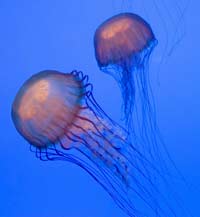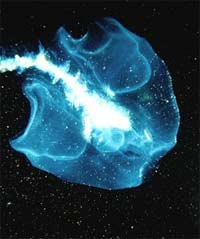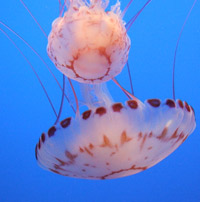
Passive drifters: Most jellyfish are passive drifters that feed on small fish and zooplankton that become caught in their tentacles. Jellyfish have an incomplete digestive system, meaning that the same orifice is used for both food intake and waste expulsion. They are made up of a layer of epidermis, gastrodermis, and a thick jellylike layer called mesoglea that separates the epidermis from the gastrodermis.
 Unimportant swimming skills: Their shape is not hydrodynamic, which makes them slow swimmers. But speed and low water resistance are not important as they are drifters that feed on plankton. It is more important for them that their movements create a current where the water (which contains their food) is being forced within reach of their tentacles. They accomplish this by having a body shaped like a bell which is rhythmically opened and closed. Unimportant swimming skills: Their shape is not hydrodynamic, which makes them slow swimmers. But speed and low water resistance are not important as they are drifters that feed on plankton. It is more important for them that their movements create a current where the water (which contains their food) is being forced within reach of their tentacles. They accomplish this by having a body shaped like a bell which is rhythmically opened and closed.
Cup shaped jellies: Since jellyfish do not biologically qualify as actual "fish", the term "jellyfish" is considered a misnomer by some, who instead employ the names "jellies" or "sea jellies". The name "jellyfish" is also often used to denote either Hydrozoa or the box jellyfish, Cubozoa. The class name Scyphozoa comes from the Greek word skyphos, denoting a kind of drinking cup and alluding to the cup shape of the animal.
 Defense and feeding mechanisms: Most jellyfish have tentacles or oral arms coated with thousands of microscopic nematocysts; generally, each of these nematocyst has a "trigger" (cnidocil) paired with a capsule containing a coiled stinging filament, as well as barbs on the exterior. Upon contact, the filament will swiftly unwind, launch into the target, and inject toxins. It can then pull the victim into its mouth, if appropriate. Defense and feeding mechanisms: Most jellyfish have tentacles or oral arms coated with thousands of microscopic nematocysts; generally, each of these nematocyst has a "trigger" (cnidocil) paired with a capsule containing a coiled stinging filament, as well as barbs on the exterior. Upon contact, the filament will swiftly unwind, launch into the target, and inject toxins. It can then pull the victim into its mouth, if appropriate.
Highly toxic few: Although most jellyfish are not perniciously dangerous to humans, a few are highly toxic, such as Cyanea capillata. The recently discovered Carukia barnesi is also suspected of causing two deaths in Australia. Contrary to popular belief, the menacingly infamous Portuguese Man o' War (Physalia) is not actually a jellyfish, but a colony of hydrozoan polyps.
The nerve net: The jellyfish can detect the touch of other animals using a nervous system called a "nerve net", which is located in its epidermis. Impulses to these nerve cells are sent from nerve rings that have collected information from the environment of the jellyfish through the rhopalial lappet, which is located around the animal's body. Jellyfish also have ocelli that cannot form images, but are sensitive to light; the jellyfish can use these to determine up from down, basing its judgement on sunlight shining on the surface of the water.
 No need for a respiratory system: Jellyfish do not have a specialized digestive system, osmoregulatory system, central nervous system, respiratory system, or circulatory system. They are able to digest with the help of the gastrodermis that lines the gastrovascular cavity, where nutrients from their food is absorbed. They do not need a respiratory system since their skin is thin enough that oxygen can easily diffuse in and out of their bodies. Jellyfish have limited control over their movement and mostly free-float, but can use a hydrostatic skeleton that controls the water pouch in their body to actuate vertical movement. No need for a respiratory system: Jellyfish do not have a specialized digestive system, osmoregulatory system, central nervous system, respiratory system, or circulatory system. They are able to digest with the help of the gastrodermis that lines the gastrovascular cavity, where nutrients from their food is absorbed. They do not need a respiratory system since their skin is thin enough that oxygen can easily diffuse in and out of their bodies. Jellyfish have limited control over their movement and mostly free-float, but can use a hydrostatic skeleton that controls the water pouch in their body to actuate vertical movement.
Blooms and grouping: A group of jellyfish is often called a "smack." Many species of jellyfish are also capable of congregating into large swarms or "blooms" consisting of hundreds or even thousands of individuals. The formation of these blooms is a complex process that depends on ocean currents, nutrients, temperature and oxygen content. Jellyfish will sometimes mass breed during blooms, thereby causing large booms in jellyfish population and reportedly raising major ecological concern for a possible jellyfish outbreak.
 According to Claudia Mills of the University of Washington, the frequency of these blooms may be attributed to mankind's impact on marine life; she says that the breeding jellyfish may merely be taking the place of already overfished creatures. Jellyfish researcher Marsh Youngbluth further clarifies that "jellyfish feed on the same kinds of prey as adult and young fishes, so if fish are removed from the equation, jellyfish are likely to move in." According to Claudia Mills of the University of Washington, the frequency of these blooms may be attributed to mankind's impact on marine life; she says that the breeding jellyfish may merely be taking the place of already overfished creatures. Jellyfish researcher Marsh Youngbluth further clarifies that "jellyfish feed on the same kinds of prey as adult and young fishes, so if fish are removed from the equation, jellyfish are likely to move in."
Increased nutrient in the water, ascribed to agricultural runoff, has also been cited as an antecedent to the recent proliferation of jellyfish numbers: scientist Monty Graham says, "ecosystems in which there are high levels of nutrient ... provide nourishment for the small organisms on which jellyfish feed. In waters where there is eutrophication, low oxygen levels often result, favoring jellyfish as they thrive in less oxygen-rich water than fish can tolerate. The fact that jellyfish are increasing is a symptom of something happening in the ecosystem."
 By sampling sea life in a heavily fished region off the coast of Namibia, researchers have found that jellyfish have actually overtaken fish in terms of the biomass they contribute to this ocean region. The findings represent a careful quantitative analysis of what's been called a "jellyfish explosion" after intense fishing in the area in the last few decades. The findings are reported by Andrew Brierley, of the University of St. Andrews, and his colleagues in the July 12, 2006 issue of the journal Current Biology. By sampling sea life in a heavily fished region off the coast of Namibia, researchers have found that jellyfish have actually overtaken fish in terms of the biomass they contribute to this ocean region. The findings represent a careful quantitative analysis of what's been called a "jellyfish explosion" after intense fishing in the area in the last few decades. The findings are reported by Andrew Brierley, of the University of St. Andrews, and his colleagues in the July 12, 2006 issue of the journal Current Biology.
Areas seriously affected by jellyfish blooms include the northern Gulf of Mexico, where "moon jellies have formed a kind of gelatinous net that stretches from end to end across the gulf," and the Adriatic Sea.
Jellyfish in captivity: Jellyfish are commonly displayed in aquaria across the United States and in other countries; among the more known are the Monterey Bay Aquarium, Vancouver Aquarium, and Maui Ocean Center. Often the tank's background is blue with the animals illuminated by side lighting to produce a high contrast effect. In natural conditions, many of the jellies are so transparent that they can be almost impossible to see.
Holding jellies in captivity also presents other problems: for one, they are not adapted to closed spaces or areas with walls, which aquaria by definition have. They also depend on the natural currents of the ocean to transport them from place to place. To compensate for this, most professional exhibits feature water flow patterns. The Monterey Bay Aquarium uses a modified version of the "kreisel" (German for "spinning top") for this purpose.

Treatment of stings: When stung by a jellyfish, first aid may be in order. Though most jellyfish stings are not deadly, other stings, such as those perpetrated by the box jellyfish (Chironex fleckeri) — the most venomous marine creature and possibly the most venomous of any creature on earth — may be fatal. Serious stings may cause anaphylaxis and eventual paralyzation, and hence people stung by jellyfish must get out of the water to avoid drowning. In these serious cases, advanced professional care must be sought. This care may include administration of an antivenin and other supportive care such as required to treat the symptoms of anaphylactic shock.
3 Goals when stung: There are three goals of first aid for uncomplicated jellyfish stings: prevent injury to rescuers, inactivate the nematocysts, and remove any tentacles stuck on the patient. To prevent injury to rescuers, barrier clothing should be worn. This protection may include anything from panty hose to wet suits to full-body sting-proof suits. Inactivating the nematocysts, or stinging cells, prevents further injection of venom into the patient. Five percent acetic acid solution (white vinegar) is the preferred method, although meat tenderizer, or sodium bicarbonate (baking soda) will neutralize any nematocysts that  have not yet discharged into the skin. Meat tenderizer should not be left on the skin for more than 15 minutes, and none of these substances should be used in the eyes. In the case of stings on or around the eyes, the solution may be placed on a towel and dabbed around the eyes, but not in them. Salt water may also be used in case any of these compounds are not readily available, but fresh water should never be used. Rinsing the sting site with fresh water, rubbing the wound, or using alcohol, spirits, ammonia, or urine will encourage the release of venom. have not yet discharged into the skin. Meat tenderizer should not be left on the skin for more than 15 minutes, and none of these substances should be used in the eyes. In the case of stings on or around the eyes, the solution may be placed on a towel and dabbed around the eyes, but not in them. Salt water may also be used in case any of these compounds are not readily available, but fresh water should never be used. Rinsing the sting site with fresh water, rubbing the wound, or using alcohol, spirits, ammonia, or urine will encourage the release of venom.
Deactivated stinging cells: Once deactivated, the stinging cells must be removed. This can be accomplished by picking off tentacles left on the body. First aid providers should be careful to use gloves or another readily available barrier device to prevent personal injury, and to follow standard universal precautions. After large pieces of the jellyfish are removed, shaving cream may be applied to the area and a knife edge, safety razor, or credit card may be used to take away any remaining nematocysts.
Beyond initial first aid, antihistamines such as diphenhydramine (Benadryl) may be used to control skin irritation (pruritis).

Two body forms through life: Most jellyfish pass through two different body forms during their life cycle. The first is the polyp stage; in this phase, the jellyfish takes the form of either a sessile stalk which catches passing food, or a similar free-floating configuration. The polyp's mouth  and tentacles are located anteriorly, facing upwards. and tentacles are located anteriorly, facing upwards.
Medusa! In the second stage, the jellyfish is known as a medusa. Medusae have a radially symmetric, umbrella-shaped body called a bell. The medusa's tentacles hang from the border of the bell. This is the form most people know jellyfish as.
Jellyfish are dioecious (that is, they are either male or female). In most cases, to reproduce, a male releases his sperm into the surrounding water. The sperm then swims into the mouth of the female jelly, allowing the fertilization of the ova process to begin. Moon jellies, however, use a different process: their eggs become lodged in pits on the oral arms, which form a temporary brood chamber to accommodate fertilization.
After fertilization and initial growth, a larval form, called the planula, develops from the egg. The planula larva is small and covered with cilia. It settles onto a firm surface and develops into a polyp. The polyp is cup-shaped with tentacles surrounding a single orifice, perhaps resembling a tiny sea anemone. Once the polyp begins reproducing asexually by budding, it's called a segmenting polyp, or a scyphistoma. New scyphistomae may be produced by budding or new, immature jellies called ephyra may be formed. Many jellyfish can bud off new medusae directly from the medusan stage.
All text is available under the terms
of the GNU Free Documentation License
|